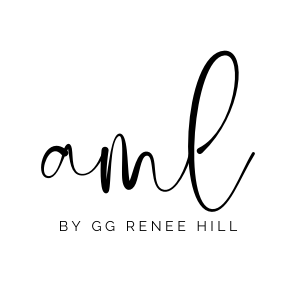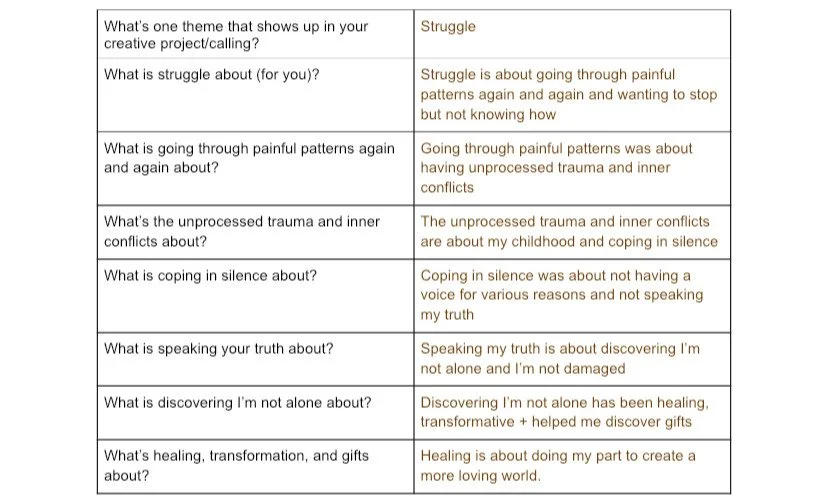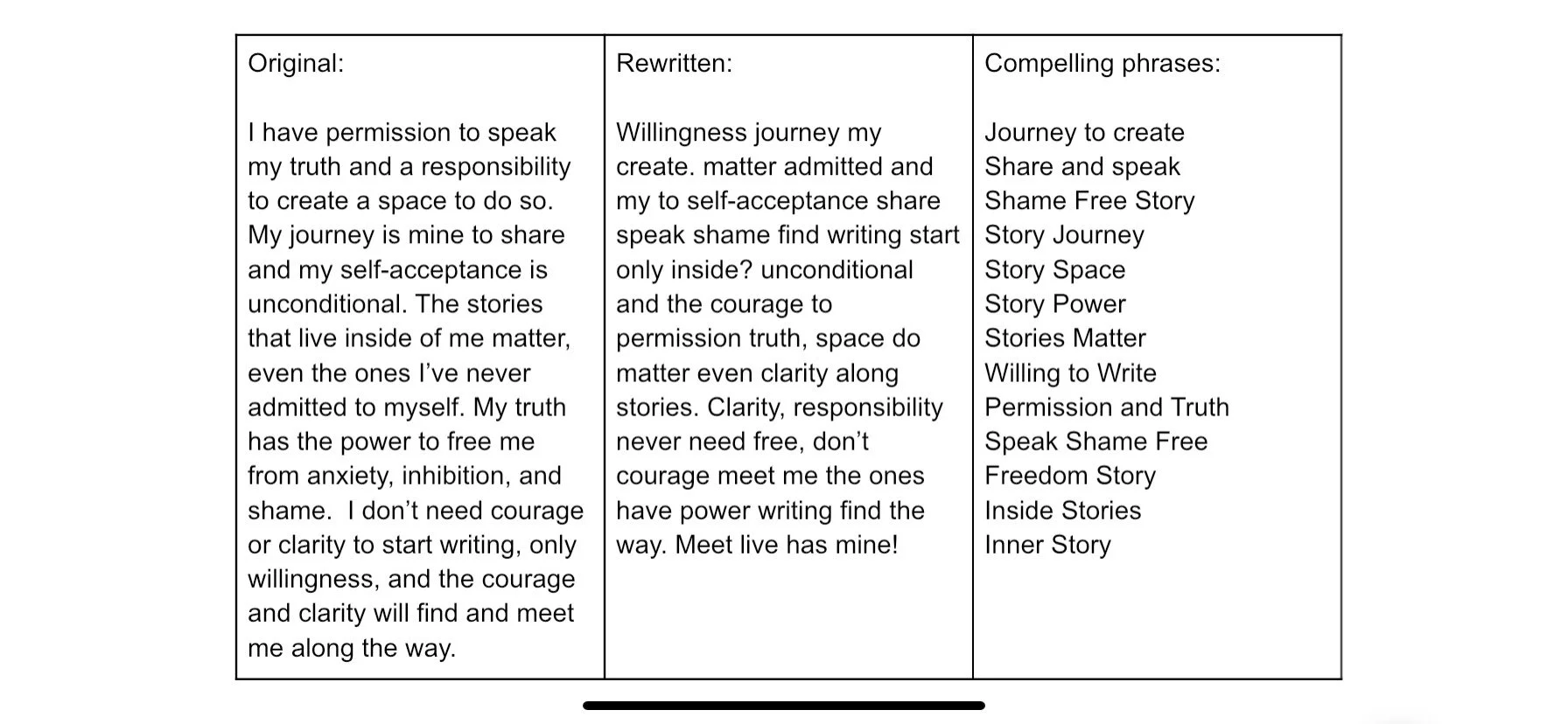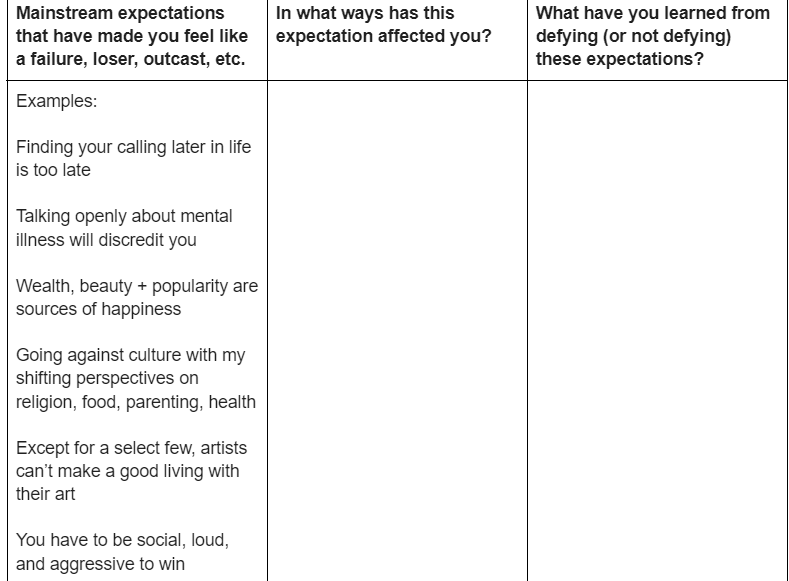cowriting warm up exercises
Each exercise corresponds with a weekly email which you can access by clicking the dates below.
YOU CAN DOWNLOAD A PDF WITH ALL THE WEEKLY EMAILS AND EXERCISES HERE.
Week One — August 30/September 1
…
Take Creative Types Quiz and read the summary that describes your results. Write a letter to the part of yourself described by your creative type. What does she/they need to hear? Write with the goal of empowering this part of you. I approached this by pulling out a line that really made me feel seen, and I used it as a prompt:
“The world is a place of beauty and magic in the eyes of a dreamer. Where others see facts and figures, you see symbols, metaphors and hidden meanings.”
How many of us have questioned our creative instincts and gifts over the years? This exercise is to help us start unraveling any limiting perceptions that lead to creative blocks.
Week TWO — SEPTEMBER 6/September 8
…
This week's warm up exercise is about choosing projects that satisfy an authentic need or inner curiosity, and how choosing this way helps us stay committed, reap the benefits, and grow from the challenges. Reflect on the following prompts and if you find it helpful, you can recreate the table below to organize your thoughts. I’ve provided an example for reference.
What is your creative calling and how can you channel your calling into a practice, goal, or project that makes sense in your life right now?
How does this practice, goal, or project reflect an emotional need that you’re aware of right now? What is it you need to say, explore, unpack, share, or get involved with? What benefits and challenges do you see coming from this? What unique perspective, gifts, and approach do you bring to this project? (thanks for this additional prompt, Natasha!)
WEEK THREE — SEPTEMBER 13/SEPTEMBER 15
…
This exercise focuses on the connection between your project/calling and life themes. You can explore as many themes as you want with this exercise, but I suggest doing one theme at a time.
Start with: What’s one theme that shows up in your creative project/calling?
In the example below, the theme I’m sharing is struggle.
The next question is: What is {insert your theme} about for you?
Then, ask the same question using your answer as the subject. Keep drilling down by continuing to ask the question using the subject of each answer as many times as it takes to uncover layers that relate to your theme and project. Stop when you feel that you’ve reached a core truth about what you want your project to say, reflect, or do as it relates to this theme.
WEEK FOUR — SEPTEMBER 20/SEPTEMBER 22
…
Exercise from Natalie Goldberg’s Writing Down the Bones p. 67
Goldberg says that by cracking open syntax, we release energy and are able to see the world from different angles. This exercise allows you to play with words which makes language less intimidating and lowers resistance to raw, unpolished writing. Conceptually, it allows us to break rules and see things with fresh eyes to reveal new artistic choices.
1. Find three or four lines from your journal or you can freestyle write a few sentences now. The sentences do not have to be profound or deep.
2. Copy or write your sentences on a blank page. Below that, rewrite your sentences, mixing up the words in any order with no regard to meaning, grammar, or punctuation.
3. Resist the urge to make it make sense and the urge to get caught up in rules. Do your rewrite recklessly and feel free to repeat or add words if you feel the impulse.
4. Next, add punctuation wherever you like, still unconcerned with meaning or grammar. Add the punctuation like you are decorating a picture.
5. Now read it aloud to yourself in different ways, expressing different moods and emotions.
6. When you’re done, make a note of any compelling phrases or images that come up for you.
One way to use this exercise is to explore key words and phrases to center an idea you’re trying to formulate. I used it to brainstorm names for a storytelling project that I’m working on. I pulled a few lines from content that I already had in my archives. Now, maybe I can narrow down and experiment with these compelling phrases that I pulled from the rewrite to name my project!
WEEK FIVE — SEPTEMBER 27/SEPTEMBER 29
Choose one task related to your project or calling that often gets avoided, neglected, and deprioritized. First, make a list of reasons why this task gets avoided and neglected. Dig deep and be honest with yourself. Then, brainstorm reminders, reflections, ideas, and inspired actions for changing your attitude towards this task/project.
Example:
One of my creative projects right now is a book project that I’ve been working on off and on for years. It tends to fall to the bottom of my priority list. In the example below, I examine why I neglect this project. I discovered that the inner conflict that causes me the most resistance is the second one, and I will continue to explore ways to work with this.
WEEK six — OCTOBER 4/OCTOBER 6
As you nurture your creative lifestyle and projects, be mindful of measuring yourself against cultural and societal standards and think about how you need to support yourself when your choices set you apart. Tune into your differences and be aware of the special knowledge you have gained from the way your life has defied 'normality'. In what ways can you find empowerment in being a misfit and not fitting in? The following exercise asks you to consider the mainstream expectations that have affected your creative choices and what you’ve learned from defying or not defying those expectations. After doing this exercise, also consider:
— What other self-reflection questions does this exercise trigger for you?
— How might your creative project or calling defy mainstream expectations? In what small ways can you prepare yourself for possible outcomes?
I have provides some examples from my personal journal in the table below.
WEEK sEVEN — OCTOBER 11/OCTOBER 13
Just like any other form of discomfort, a creative block holds information. It can tell you that something else needs attention. They remind us to pause, ask ourselves what we need, and pay attention to what truths come up. Even when they are inconvenient or initially seem to make your life harder. Sometimes it’s an emotional inner conflict that needs attention. Sometimes it’s what’s on our plates, our routines, and mental hygiene. Sometimes we are being called into greater surrender. The practical takeaway here is to engage in frequent self check-ins, asking yourself what you need.
For our warm-up, let’s use our personal experiences with creative blocks to stretch ourselves creatively and practice storytelling. This exercise will help you create a new mental pathway when you face creative blocks. As an example, I’m sharing a fictionalized version of an experience that used to make me feel pitiful and disempowered, that now is a source of inspiration. When I face creative blocks, this is now on the list of several examples I can refer to when a creative block served as helpful information in the long run. As a writer, this exercise helps me practice incorporating more elements into my writing.
EXAMPLE:
week eight — october 18/october 20
Memoirist Dani Shapiro says ‘the practice is the art.’ By practicing in public, you find the people who are drawn to your art. The people who resonate with your expression and your message even when it’s raw and unrefined. Practice is how we get from where we are to where we want to be in a healthy way that honors the process. It provides you with a track record, so you can map your discoveries, improvements, and expansions. And if you’re looking for a natural source of momentum, there’s nothing more effective than taking inspired action in this way. This week’s reminder is to not let your fears keep you from practicing, and in fact, when you look at it as exposure therapy, you can give yourself assignments and experiments to help you discover ways to practice in public.
Our warm up this week includes the following prompts:
— Are your creative goals and callings being expressed publicly right now? If yes, how so? If not, why not?
— What do you fear most about practicing in public? What’s the worst that could happen?
—Put on your no filter, no limit mindset and think about what practicing in public looks like for you. List as many ways you can think of that could serve as your own unique ‘exposure therapy’ or in other words, small steps to start taking up space in new ways, adjusting in small, steady steps to your ever-expanding identity as a creative.
After the Tuesday session, India shared the following additional prompts that this exercise brought up for her:
— What is my relationship with my art? What relationship do others have with my art?
— What part of myself do I want to separate from my art?
— How important is admiration and acceptance to make my art feeling meaningful?
WEEK NINE — OCTOBER 25/OCTOBER 27
If we hold a core belief that there is never enough of anything to go around, that belief is going to show up in our creative choices and how we think about our own possibilities. But when we practice reorienting our minds away from scarcity thinking even a little bit, it can help us consider new ways of expressing ourselves with authenticity and wholeness. If we stop habitually looking for scarcity in our lives and in others, and start taking action from a place of worthiness, then we can set an example of how we want the world to be.
Instead of judging our experiences based on the spectrum of praise and criticism, how can we take stock of how we feel about ourselves after we’ve shown up authentically?
To explore this topic, let’s do a freewriting exercise. For this freewrite, experiment with the technique of writing without grammar or punctuation. The purpose of this is to practice the freedom of navigating the traffic of your thoughts without any brakes. Choose one or more of the following prompts to start your freewrite:
Freewrite about areas of your life that often trigger a “not enough” narrative. What keeps you from feeling whole and worthy in these areas?
If you lost your reputation, track record, and accomplishments, what would you do without the worthiness or unworthiness that these things give you?
If you detached worthiness from productivity, popularity and other external factors, what benchmarks would you use to measure it?
In what ways does judgment of others influence your judgment of self?
WEEK TEN— NOVEMBER 1/NOVEMBER 3
Many writers I’ve worked with talk about not being disciplined enough, finding it more natural to be consistent in other areas of their lives and how frustrating that can be. It makes sense though because with creativity we have to pave our own path to find what works for us and we’re facing inner and outer critical voices along the way. Your calling then feels more like a duty, the way it calls to you and makes you feel guilty for neglecting it, the way you have to face your insecurities and self-doubt when you spend time with it. To dissolve this block, think of your creative practice as a reward, not a duty and find ways to put this into practice. When we get mad at ourselves because someone else’s process doesn’t work for us, we are only creating more resistance. William Burroughs said, “there is no such thing as will power. Only need.” This bring us back to remembering our authentic needs, and redefining what discipline looks and feels like for us.
Let’s do an exercise to get creative with our reflections on this topic.
First fold your page in half. For this exercise, only write on one side of the page. If you’re using a computer you can create a two-column table like I did below.
Reflect on a moment that you associate with a struggle with discipline. A moment or time in your life that you struggled to be consistent about something you knew was good for you or that you wanted.
Once you have this moment in your mind, think of a scene that captures it. For mine, I thought about how I could never get into the habit of walking and how I used to beat myself up for being lazy until I started incorporating it into my morning routine with my daughter. That’s the thought I started with and then I just ran with it and tried not to overthink it.
Write until you feel like your done, but don’t go longer than one side of the page.
Next, you’re going to make a poem out of your journaling on the other side of the page, or in your second column. Grab a word or phrase from the top line and make it the first line of your poem. Grab a word or phrase from the bottom line and make it the next line of your poem. Crossing off as you go, grab a word or phrase from the top and then the bottom until you get to your last line. You can try to maintain the meaning or just let your inner artist create a new meaning.
WEEK ELEVEN — NOVEMBER 8/NOVEMBER 10
This week we are talking about the idea of separating rational and intuitive tasks in our creative process. In her Intuitive Writing course, Lauren Sapala says, “One of the biggest reasons rational writing methods don’t work for intuitive writers is because there is so much overlap between writing and editing, forcing them to move back and forth between right and left-brain states, which ultimately shuts down their creativity. This difficulty is compounded by the tendency of many intuitive writers to start editing too soon out of fear and anxiety about “where the story is going.” Many writers rationalize that they are using editing as a way to better understand the story, when in fact, they are actually using it as a source of comfort so that they can feel more in control of the process.”
She suggests allowing for a grieving period between writing and editing so you can fully let go and transition from the intuitive to rational mindset. Her guidance to write the complete draft before you go back to read any of what you’ve written may not be right for you, but if you struggle with editing as you write, it’s worth experimenting with different ways to see how this separation could work for you.
Today, our exercise is to write a letter saying goodbye to the receiving and channeling part of the writing process, and hello to the structured, discerning part of the process. This letter can be posted up in your work area as a reminder to value of both parts of the process, and why they both need their space.
WEEK TWELVE — NOVEMBER 15/NOVEMBER 17
“It is my belief and my experience as a teacher that all of us are healthy enough to practice creativity. It is not a dangerous endeavor requiring trained facilitators. It is our human birthright and something we can do gently and collectively. Creativity is like breathing – pointers may help, but we do the process ourselves. Creative clusters, where we gather as peers to develop our strength, are best regarded as tribal gatherings, where creative beings raise, celebrate, and actualize the creative power which runs through us all.” — Julia Cameron
Write a reflection about your experience with Reclaim or to write a reflection about how you'll meet your creative needs going forward.









